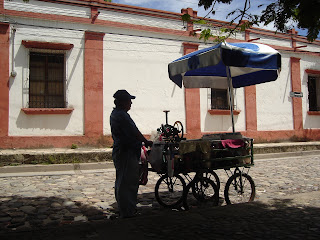In Copan, staying with the local peace corps volunteer. Hiking into Brisas almost every day and working with the women. Cecilia, Cata, Luisa, Soyla, Marina. Exhausting, but good. The library itself still isn't much to see, but I've been focusing on a different kind of work. The women have been working with the books, learning how to wrap them and prepare them for the library. Soon we'll be starting in on the Dewey decimal system and the card catalog.
Wrapping books. We worked outside. Lots of chickens and skinny dogs running around. One chick got stuck on a piece of contact paper. Below, Oneida, Luisa's daughter.

Weaving. The women in Brisas already know how to weave pretty well. Purses out of yarn on small hand looms. They use plastic combs to push the rows of yarn together. We worked on making different kinds of designs. I showed them how to make hands. From left, Cecilia, Marina, Luisa.

Making flowers out of fabric to decorate the finished purses.
Lady, Jose Manuel's daughter, with a library book. Eric Carle. El canguro tiene mama?

 Laying the level line around the building's perimeter.
Laying the level line around the building's perimeter.

 To the public library in Copan. Everyone's first time visiting a library, of any sort. The idea was for the women to see how a library looks, how it works.
To the public library in Copan. Everyone's first time visiting a library, of any sort. The idea was for the women to see how a library looks, how it works.
 6 women, 12 purses. Everybody finished one practice purse with hands.
6 women, 12 purses. Everybody finished one practice purse with hands.
 Jose Manuel's machete in the trail.
Jose Manuel's machete in the trail.

















